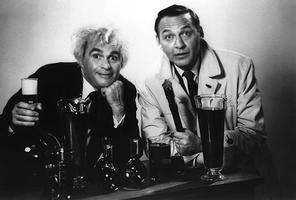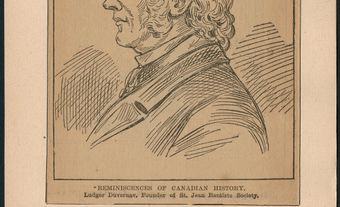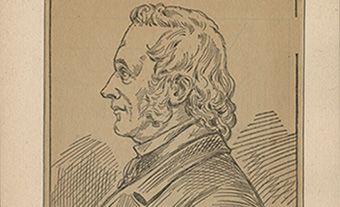Television Programming
Television must provide information and entertainment suited to the tastes and needs of a very large public. This cultural fact dictates that television programming will come in many different forms: newscasts and news magazines or documentaries, talk shows, sports broadcasts, games and quizzes, variety shows, and children's programs, as well as a range of dramatic entertainment. The same fact helps to explain why this programming appears repetitive, even hackneyed, for familiarity breeds popularity; why it is expensive, since success requires stars and high production values; and why it commonly employs the format of storytelling, because no other mode of explanation or diversion is so universally accepted.What has been called the golden age of Canadian programming occurred during the first decade of television (1952-62), when the publicly owned CANADIAN BROADCASTING CORPORATION enjoyed a monopoly of network broadcasting. The CBC organized separate French- and English-language networks (which reached over 85% of Canadian homes by 1962), beginning its schedule at first in the evening for family viewing but slowly extending into the afternoon for women, children and teenagers. Producers created a mix of programming, representative of all the major forms of television and derived from their past experience with radio, as well as from lessons learned from British and American initiatives. It proved to be a time of excitement and experiment.
The CBC was determined to inform the public about life and affairs. Regular newscasts commenced in the spring of 1954 on both networks. Much air time was devoted to major, and sometimes controversial, public affairs shows, notably "Point de mire" (1956-59) hosted by René LÉVESQUE and "Close-Up" (1957-63) produced by Ross McLean. There were talk shows, interview series such as Toronto's popular "Tabloid," specializing in personalities, and sports roundups such as the "Jim Coleman Show."
Even greater effort went into entertainment, reflecting the special importance of television as the main source of mass diversion. Highbrows could enjoy the quiz show "Fighting Words," regular concert hours and, more infrequently, ballets, operas and sophisticated drama. Sports fans were better served with weekend broadcasts of hockey and football - the telecast of National Hockey League games began in 1952. Montréal producers developed a host of games and quizzes with titles like "Le nez de Cléopâtre" and "La clé de champs," although it was their Toronto counterparts who fashioned the long-lasting FRONT PAGE CHALLENGE in the summer of 1957.
The English-language service worked hard to foster variety favourites: the comedy team of Johnny Wayne and Frank Shuster (see WAYNE AND SHUSTER), that enduring singing star JULIETTE (Sysak), and assorted country-music groups such as those led by Gordie Tapp, King Ganam, Tommy Common, Tommy HUNTER and Don MESSER. Both networks boasted a number of dramatic anthologies - "Téléthéâtre," "General Motors Presents," "En Première" and "Festival" - which specialized in original plays.
Only Radio-Canada, the French-language network, succeeded in the realm of popular drama with a series of téléromans such as "La Famille Plouffe," "La Pension Velder" and "Marie Didace," each drawing upon the history and culture of Québec (see TELEVISION DRAMA, FRENCH-LANGUAGE).
Many of these programs proved successful. French Canadian television, in particular, won enormous audiences, earning the title of a tribal medium because it seemed to reflect the "soul" of old and new Québec. Yet there were signs of trouble ahead. In the 1950s the CBC was unable to manufacture an appealing brand of popular English Canadian drama, although it tried with "The Plouffe Family" (1954-59), with a prime-time historical adventure series for children called "Radisson" (1957-58), and with a big-budget crime drama entitled "RCMP" (1959-60).
To its evening schedule, the network added American situation comedies and action/adventure series such as "I Love Lucy" and "Have Gun, Will Travel." Even Radio-Canada began to air translations of American shows like "The Naked City" (a crime drama) and "The Donna Reed Show" (a situation comedy). Furthermore the CBC soon discovered that imported variety, such as "The Ed Sullivan Show" or "The Perry Como Show," was usually judged more pleasing by English Canadian audiences than the homegrown equivalent.
In competitive markets such as Toronto and Vancouver, where viewers could easily pick up American stations, the CBC lost large chunks of its audience at peak times when Canadian shows were aired. Indeed, across the country, public pressure had increased for greater choice, an end to the CBC monopoly, and a more popular style of television entertainment modelled on the American experience.
One myth of the times was that commercial interests would somehow fashion a television service which could act as an agency for made-in-Canada popular culture. Moreover, in 1959, the Board of Broadcast Governors had issued a series of Canadian-content regulations which were supposed to ensure the persistence of indigenous programming. These served to justify the introduction of a new era of competition, which had changed the shape of Canadian television by the mid-1970s. Acting first through the BBG and later through the CANADIAN RADIO-TELEVISION AND TELECOMMUNICATIONS COMMISSION, the state licensed competing stations across the land, authorized the operations of private networks (the English-language Canadian Television Network, or CTV, in 1961, Télé-Diffuseurs Associés or TVA in Québec in 1971 and Global in Ontario in 1974), and allowed the extension of CABLE TELEVISION to over 40% of Canadian households by 1975.
The language and culture of French Canada ensured the survival of local programming in Québec. Yet there were changes. The dramatic anthologies of the 1950s virtually disappeared, because French-language programmers, especially those on the independent station CFTM-Montréal, turned to movies to win peak-time audiences. The amount of American programming did rise, particularly on the non-CBC stations. Yet from the beginning CFTM-Montréal originated variety programs to showcase Québec's comedians and singers.
Nor did popular drama suffer. The homegrown situation comedy, Radio-Canada's "Moi et l'autre," running 9:00-9:30 PM on Tuesdays (1966-71), purportedly at- tracted around 2 million viewers a week in the early 1970s. The private challenger, TVA, had to respond with its own series. And Radio-Canada strove to improve the quality of its information programming by moving the newscast "Télé-journal" to 10:30 PM (1971-72), by adding a popular late-night talk show on Fridays with Lise Payette, entitled "Appelez-moi Lise," and by broadening the scope of its public-affairs and feature programming.
A survey of programming 1974-75 showed that Radio-Canada offered a more balanced schedule of quality performances in the realm of drama, music and dance (5%), information (32%) and light entertainment (63%), while TVA was emphatically popular, emphasizing light entertainment (82%) and a limited quantity of information (18%). The rival networks shared almost equally the French Canadian audience.
Events took a very different course in English Canada. The only route to quick popularity open to the newcomers was to schedule as many Hollywood-produced shows during prime-time as could be allowed under what proved to be the very loose regulations about Canadian content. So CTV's evening schedule 1966-67 offered the American favourites "The FBI," "Bewitched," "Dean Martin," "Mission Impossible," "Run for your Life" and "The Jackie Gleason Show." Global's schedule was similarly peppered with imports a decade later. What might seem more puzzling was that the same could be said of the CBC.
One explanation was financial: a typical 1974-75 import cost $2000 a half- hour (the actual production cost being roughly $125 000) and yet it could generate a profit of between $20 000 and $24 000 in advertising revenue on the CBC or CTV. Contrast this with domestic production: a half-hour show cost about $30 000 (meaning its production values were inferior to American shows) and realized a profit of $55 on CTV and a loss of $2050 on the CBC. The scheduling of a Canadian show, moreover, usually meant a loss of audiences and revenues in that time slot, since viewers could change channels to find an import that was more appealing.
True, the networks did offer variety and game shows where the costs could be kept down. On the CBC, "Front Page Challenge" continued, Tommy Hunter became a regular with his own show and "The IRISH ROVERS" rose to fame; CTV boasted such imitations as "Headline Hunters," "The Ian Tyson Show" and "Pig & Whistle." CTV actually had a Canadian situation comedy, "Excuse My French" (1974-75), on which it was losing about $14 000 an episode. Both networks offered wide sports coverage. In effect, however, the networks had given up the notion of competing effectively with Hollywood for mass audiences.
Where the CBC and eventually CTV did work hard was in the fields of news and public affairs, genres which capitalized on viewers' interest in their collective or public life. Early on, the CBC aired one smash hit in the field of public affairs, THIS HOUR HAS SEVEN DAYS (1964-66), a news magazine which boasted an eclectic mix of showbiz techniques, hard reporting and interviewing, and much editorializing to win a huge audience of excited viewers. "Seven Days" was a highly dramatic show, a collection of sensational stories, which sparked too much controversy to survive on an increasingly cautious network. This said, the network did carry excellent documentaries, did offer a range of features and public-affairs shows like "Telescope," "Man Alive," "Take 30," and "the fifth estate," and did improve "The National," its nightly newscast.
Though less active, CTV aired an equivalent national newscast, a major news magazine called "W5," and a news documentary series entitled "Maclear." Indeed the record of English Canadian television was better than that of its American counterpart.
Competition had brought English Canadians a breathtaking range of choice. The CBC remained the most balanced network, giving viewers a diversity of program types, while CTV and Global were clearly more restricted and popular in their offerings. Cable brought in several American channels. Ratings data showed that the CBC had lost heavily in the competition for viewers amongst English-language channels. By 1984 US stations had captured a third of the audience, CTV slightly under 30% (falling from a higher total in the mid-1970s), the CBC nearly 24%, and other independent Canadian stations 15%. Put another way, some 65% of the programs people viewed on English-language television were foreign (and overwhelmingly American) in origin. This figure has remained constant.
This situation has provoked a series of agonizing reappraisals of the whole television scene. Even so, the situation has not changed dramatically since the mid-1970s, except perhaps to worsen. News, public affairs, sports and, in Québec, the téléromans remain the best and most popular forms of Canadian television. In English Canada, the CBC attempted to bring about a renaissance, increasing the amount of Canadian content in prime time and returning to the field of light entertainment. This resulted in the highly successful family program "The Beachcombers," a hit situation comedy "The King of Kensington," an assortment of variety specials, the serial "Home Fires," and above all "The National/Journal," a combination of news and views on weekdays from 10:00 to 11:00 PM.
The private networks did not follow the CBC's lead, perhaps because competition raised the costs of acquiring foreign programs and threatened their profit margins. The CRTC's efforts to coerce more Canadian drama out of the CTV, and by implication out of all private stations, have been fiercely resisted. The government's plans to foster more Canadian production through the licensing of PAY TELEVISION, a willingness to subsidize independent producers, and the revamping of Canadian content regulations have not yet borne fruit.
Everywhere in Canada, American imports and stations have retained their importance. The audience share of the most Canadian network, the CBC and Radio-Canada, has fallen from roughly a half of the national audience in 1967 to stabilize just above a quarter in the 1980s. Statistics show that even the viewers of French-language television watch a lot of dubbed Hollywood drama (up to 80% of all drama viewed in 1984 was foreign produced), which has raised fears that Québec will fall victim to the same ills that afflict English Canada. Hollywood movies, prime-time soap operas such as "Dallas," children's shows such as "The Wonderful World of Disney" and situation comedies such as "The Cosby Show," typically dominate the rankings.
Although Canada has built one of the most sophisticated television systems in the world, the irony still remains that it has not been able to fill that system with the products of its own culture.
See also BROADCASTING, RADIO AND TELEVISION; COMMUNICATIONS IN THE NORTH; COMMUNICATIONS IN QUÉBEC; MUSIC BROADCASTING.

 Share on Facebook
Share on Facebook Share on X
Share on X Share by Email
Share by Email Share on Google Classroom
Share on Google Classroom




